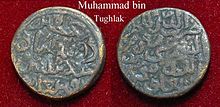Muhammad bin Tughluq
Muhammad bin Tughluq (also Fakru d-Din Muhammad Jauna Khan ; Arabic محمد بن تغلق, DMG Muḥammad b. Tuġluq ; * around 1300; † March 20, 1351 in Sindh ) was Sultan of Delhi from 1325 to 1351 .
biography
Muhammad bin Tughluq was the eldest son of Ghiyas-ud-din Tughluq Shah I , the then governor of Panjab , a northern border province in the Sultanate of Delhi . He received extensive upbringing and training. Historians describe him as intelligent, well-read, ambitious and unscrupulous. He became a soldier and gained considerable fame as a general. In 1319 his father Ghiyas-ud-din became sultan after considerable unrest, as his predecessor had no male descendants. Muhammad stayed in the military and carried out further conquests, but his thirst for power grew. His father died in 1325, but he had previously designated his son as his successor. He ascended the throne as Sultan al-Mujahid Muhammad bin Tughluq.

As a ruler, he was very ambitious and tackled ambitious projects, which, however, mostly turned out to be failures. So he wanted to optimize the state finances and therefore had data on income and expenditure collected in all areas of the empire. His tax reform based on this brought massive tax increases for the majority of producers and drove many farmers into poverty. His attempt to fix this flaw through loans also failed because the farmers could not invest in new seeds amid a famine. He set up a Ministry of Agriculture to promote the cultivation of previously undeveloped land through financial incentives, but the executing officials were corrupt and the project was canceled after only three years before it could produce results. He introduced a copper currency, but it was easy to copy and quickly lost in value and was soon no longer accepted as a means of payment. Thereupon he withdrew the currency reform.
His biggest failure was the relocation of the capital from Delhi to Devagiri , more than 1000 km further south , which he renamed Daulatabad in order to better manage his empire, which reached to the southern tip of the Indian subcontinent. However, this meant that the north-western borders were no longer adequately defended. So one could not counter the Mongol invasion of 1328/29, which devastated the country as far as the Delhi region. Instead, Muhammad bribed the Mongol leader, revealing the weakness of his government to his enemies, but moved the capital back to Delhi. All of this led to the fact that during his reign the Sultan became increasingly unpopular and lost the trust of his subordinates.
Numerous rebellions occurred in Muhammad's territory, as a result of which he had to give up large parts of his empire, including all areas south of the Narmada , where the Malabar kingdom in 1335 and the Vijayanagar kingdom in 1336 and the Bahmani Sultanate after 1347 and part of the central area (in today's Rajasthan ). There were also numerous rebellions in the north-western border region (today's Pakistan and Kashmir ) and in Bengal . In 1351 he fell ill while trying to put down a rebellion in Sindh and died there on March 20, 1351. He was probably buried in his father's mausoleum in Delhi.
Others
- Ziya'-ud-Din Barani (lived at his court for over 17 years)
- Ibn Batuta (spent 7 years at his court and in his service)
Succession
Since Muhammad bin Tughluq had no offspring, his cousin Firuz Shah Tughluq became his successor.
literature
- Ashirbadi Lal Srivastava: The Sultanate of Delhi (711-1526 AD). Including the Arab Invasion of Sindh, Hindu Rule in Afghanistan and Causes of the Defeat of the Hindus in early medieval Age. 6th edition. Shiva Lal Agarwala & Company, Agra 1969.
- Peter Jackson: The Delhi Sultanate. A Political and Military History. Cambridge University Press, Cambridge et al. 1999, ISBN 0-521-40477-0 .
Web links
- Sultans of Delhi 1300–1526 (Eng.)
- Muhammad bin Tughluq (English)
| predecessor | Office | successor |
|---|---|---|
| Ghiyas-ud-din Tughluq |
Sultan of Delhi ( Tughluq Dynasty ) 1325–1351 |
Mahmud Ibn Muhammad |
| personal data | |
|---|---|
| SURNAME | Muhammad bin Tughluq |
| ALTERNATIVE NAMES | Fakr ud-Din Muhammad Jauna Khan |
| BRIEF DESCRIPTION | Sultan of Delhi |
| DATE OF BIRTH | around 1300 |
| DATE OF DEATH | March 20, 1351 |
| Place of death | Are |
